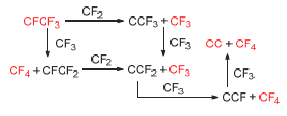| [1] Levy, R. A.; Zaitsev, V. B.; Aryusook, K. J. Mater. Res. 1998, 13, 2643.
[2] Christophorou, L. G.; Olthoff, J. K. J. Phys. Chem. Ref. Data 2000, 29, 553.
[3] Li, Y.; Patten, K. O.; Youn, D. Atmos. Chem. Phys. 2006, 6, 4559.
[4] Hamins, A.; Borthwick, P. Combust. Flame 1998, 112, 161.
[5] Su, J. Z.; Kim, A. K.; Mawhinney, J. R. J. Fire Prot. Eng. 1996, 8, 45.
[6] Su, J. Z.; Kim A. K. Fire Technol. 2002, 38, 7.
[7] Vinegar, A.; Jepson, G. W.; Hammann, S. J. Am. Ind. Hyg. Assoc. J. 1999, 60, 403.
[8] Duan, Y. Y.; Zhu, M. S.; Shi, L. Fluid Phase Equilib. 1997, 131, 233.
[9] Petrik, V.; Cahard, D. Tetrahedron Lett. 2007, 48, 3327.
[10] Nagasaki, N.; Morikuni, Y.; Kawada, K.; Arai, S. Catal. Today 2004, 88, 121.
[11] Nagasaki, N.; Suzuki, N.; Nakano, S.; Kunihiro, N. US 5892136, 1999 [Chem. Abstr. 1998, 129, 29362].
[12] Yang, G. C.; Lei, S.; Pan, R. M.; Quan, H. D. J. Fluorine Chem. 2009, 130, 231.
[13] Yang, G. C.; Jia, X. Q.; Pan, R. M.; Quan, H. D. J. Mol. Catal. A: Chem. 2009, 309, 184.
[14] Yang, G. C.; Jia, X. Q.; Pan, R. M. J. Fluorine Chem. 2009, 130, 985.
[15] Hu, Y. J.; Wu, T. P.; Liu, W. Z.; Pan, R. M. J. Phys. Chem. A 2014, 118, 1918.
[16] Figueiredo, J.; Pereira, M.; Freitas, M.; Orfao, J. Carbon 1999, 37, 1379.
[17] McDougall, G. J. J. South. Afr. Inst. Min. Metall. 1991, 91, 109.
[18] Rodriguez-Reinoso, F. Carbon 1998, 36, 159.
[19] Delley, B. J. Chem. Phys. 2000, 113, 7756.
[20] Perdew, J. P.; Burke, K.; Ernzerhof, M. Phys. Rev. Lett. 1996, 77, 3865.
[21] Delley, B. J. Chem. Phys. 1990, 92, 508.
[22] Dolg, M.; Wedig, U.; Stoll, H.; Preuss, H. J. Chem. Phys. 1987, 86, 866.
[23] Bergner, A.; Dolg, M.; Küchle, W. Mol. Phys. 1993, 80, 1431.
[24] Halgren, T. A.; Lipscomb, W. N. Chem. Phys. Lett. 1977, 49, 225.
[25] Henkelman, G.; Jonsson, H. J. Chem. Phys. 2000, 113, 9978. |
